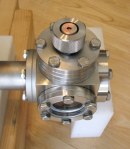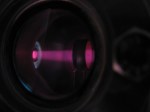Friday, February 23, 2018
neutron generator...deuterium accelerator

 Construction techniques involve drilling, lathe turning, silver brazing, and soft silver soldering. Photos at left show components of the source (most prominent are the extraction electrodes) during assembly on a ConFlat cube for testing.
Construction techniques involve drilling, lathe turning, silver brazing, and soft silver soldering. Photos at left show components of the source (most prominent are the extraction electrodes) during assembly on a ConFlat cube for testing.
Extraction of ions is accomplished by a strong DC electric field imposed between the negatively-biased “nozzle” on the 5/16″ tube and the grounded septum on the 1/2″ tube. I use up to -5 kV for extraction of ions. The extraction nozzle also throttles neutral gas flow from the discharge region into the vacuum chamber.
 RF power is supplied by an FAA-surplus AM-6155 power amplifier operating at 200 MHz. These amplifiers are a common hamfest bargain. Circuit details and modifications for the amateur radio hobby are easy to find online. To date I have not produced more than ~60W with this amplifier, driving it with signals below 1W. Beam current depends
RF power is supplied by an FAA-surplus AM-6155 power amplifier operating at 200 MHz. These amplifiers are a common hamfest bargain. Circuit details and modifications for the amateur radio hobby are easy to find online. To date I have not produced more than ~60W with this amplifier, driving it with signals below 1W. Beam current depends  very strongly on RF power, and I plan to upgrade the driver for the AM-6155 to produce more. The top photo shows this amplifier producing power (lighting a mercury-vapor discharge), and the bottom photo shows the tube compartment of the amplifier modified for shunt feed of plate current.
very strongly on RF power, and I plan to upgrade the driver for the AM-6155 to produce more. The top photo shows this amplifier producing power (lighting a mercury-vapor discharge), and the bottom photo shows the tube compartment of the amplifier modified for shunt feed of plate current.
 Inductive coupling of the 200-MHz power to the discharge plasma is effected with a single loop of heavy conductor that forms part of a resonant “L-match” circuit, providing an easy interface to 50-Ω cable. This is illustrated schematically at left. The right photo shows the ion source ready for testing, with the RF coupling loop visible along with other components including gas for the discharge (deuterium lecture bottle).
Inductive coupling of the 200-MHz power to the discharge plasma is effected with a single loop of heavy conductor that forms part of a resonant “L-match” circuit, providing an easy interface to 50-Ω cable. This is illustrated schematically at left. The right photo shows the ion source ready for testing, with the RF coupling loop visible along with other components including gas for the discharge (deuterium lecture bottle). Photos from operation. The top photo shows the RF deuterium discharge in a standard 19-mm (3/4″) Pyrex test tube, and below it a beam of extracted ions impinging on a graphite Faraday cup target. RF power is about 50W, extraction voltage -3 kV, and target at -10 kV. Background pressure has been raised into the millitorr range to enhance beam visibility. Extracted current is 0.25 milliampere.
Photos from operation. The top photo shows the RF deuterium discharge in a standard 19-mm (3/4″) Pyrex test tube, and below it a beam of extracted ions impinging on a graphite Faraday cup target. RF power is about 50W, extraction voltage -3 kV, and target at -10 kV. Background pressure has been raised into the millitorr range to enhance beam visibility. Extracted current is 0.25 milliampere.  Bottom photo shows the exit aperture clearly, with deuteron beam passing through a ring electrode at -10 kV. Here the extraction voltage was -5 kV. It is not possible to accurately measure the beam current in this arrangement, but it is probably on the order of 0.5 mA. Not surprisingly, a few neutrons from 2H(d,n) fusion reactions can be detected with higher potentials on the ring cathode.
Bottom photo shows the exit aperture clearly, with deuteron beam passing through a ring electrode at -10 kV. Here the extraction voltage was -5 kV. It is not possible to accurately measure the beam current in this arrangement, but it is probably on the order of 0.5 mA. Not surprisingly, a few neutrons from 2H(d,n) fusion reactions can be detected with higher potentials on the ring cathode.https://carlwillis.wordpress.com/tag/particle-accelerator/
actually, the neutron generator, is not a big shit, the way you saw it previous...its deuterium or heavy water (buy anywhere) with 2/3 grams of tritium, inside e reflective core......what is the generator all about? energy power source ....these means two electronic schemes : (now...I'm not the right girl, with expertise electronics....so...)
An Engineer tracking development of India's Space, Nuclear & Military Technologies.
AAME.IN
Neutron Generators are finding increasing application for accurate detection of explosives, fissile materials & narcotics. They are also extensively used in the oil & gas exploration, detecting mineral purity, as well as waste management. Neutrons generating methods include conventional Nuclear Reactors, as well as Radioisotope materials, like Pu-Be, Am-Be, Cf, utilising fission decay process to obtain Neutron. However, associated with these methods are inherent safety risk of continual radioactivity, as well as their low source strength. These setups are bulky, requiring large power source for operation.
The search for a safe & portable Neutron Generator to meet industry requirement is leading researchers to explore other processes of generation. One such method, utilising Fusion process is the Inertial Electrostatic Confinement Fusion principle. The Institute for Plasma Research [IPR], in its January 2017 Newsletter, announced operation of its Inertial Electrostatic Confinement Fusion [IECF] device, built at its Centre of Plasma Physics [CPP] campus in Nazirakhat, Assam. The first such indigenous device in India, they have reported generation of 10^8 Neutrons/second, in steady state operation, while in the pulsed mode, it is expected to produce 10^10 Neutrons/second. Being based on fusion, the reaction can be turned on and off as required, by controling the electric field and flow of gas, generating no radioactivity, when not operational.
Big shit! ok, uranium binded in glass, is basically, Uranyl Nitrate ions, which on past decades was glass for sale, still on the market of antiques. So, wild guess, guys...this uranyl nitrate, is depleted uranium...and because thermal aspect is covered, it can be...pressed...and it can be used on the core, just like that. without the need of overcome the delta phase induction
We had a problem, but we don't have it no more :) vacuum cold reduction of depleted uranium machinery, are only two companies, pretentious asshools, ok? Now... its impossible to divide the process, like, put your hands inside vacuum machine, mix the critical mass, and then take it out for using another machine for pressing (reduction) (this reduction, will turn the uranium which is nano sized 0.3 nano (another part of the question...) on metal rods (rods that are called fuel, on the nuclear reactors) ...its what we need , rods...! So, there's another preparation, called heat treatment bath of uranium, and then ultrasonic (heat control) cold reduction machine .... the bath of uranium, must be with borosilicate glass ; which is barium glass (ok barium, again...is the unique replacement chemical of the density of lead), and in that case, we coat, bind, the uranium, and then we can reduce....two different steps, safely.
ok...this boron sphere, it is a neutron moderator, but as I far as I understand, its a moderator when the critical mass is inserted it when its already joined the semi spheres. The question is...how to join it together ...I'm not sure! however, it looks like the fast transition, must be less than 210 Microseconds. which...means high precision mechanics
ok, from wikipedia "Stabilized δ-phase Pu–Ga is ductile, and can be rolled into sheets and machined by conventional methods. It is suitable for shaping by hot pressing at about 400 °C. This method was used for forming the first nuclear weapon pits.
More modern pits are produced by casting. Subcritical testing showed that wrought and cast plutonium performance is the same.[2][3] As only the ε-δ transition occurs during cooling, casting Pu-Ga is much less problematic than casting pure plutonium.[4]
δ phase Pu–Ga is still thermodynamically unstable, so there are concerns about its aging behavior. There are substantial differences of density (and therefore volume) between the various phases. The transition between δ-phase and α-phase plutonium occurs at a low temperature of 115 °C and can be reached by accident. Prevention of the phase transition and the associated mechanical deformations and consequent structural damage and/or loss of symmetry is of critical importance. Under 4 mol.% gallium the pressure-induced phase change is irreversible.
However, the phase change is useful during the operation of a nuclear weapon. As the reaction starts, it generates enormous pressures, in the range of hundreds of gigapascals. Under these conditions, δ phase Pu–Ga transforms to α phase, which is 25% denser and thus more critical" ....ε-δ (delta- to gamma phase). and α phase ...alpha, supercritical mass....
More modern pits are produced by casting. Subcritical testing showed that wrought and cast plutonium performance is the same.[2][3] As only the ε-δ transition occurs during cooling, casting Pu-Ga is much less problematic than casting pure plutonium.[4]
δ phase Pu–Ga is still thermodynamically unstable, so there are concerns about its aging behavior. There are substantial differences of density (and therefore volume) between the various phases. The transition between δ-phase and α-phase plutonium occurs at a low temperature of 115 °C and can be reached by accident. Prevention of the phase transition and the associated mechanical deformations and consequent structural damage and/or loss of symmetry is of critical importance. Under 4 mol.% gallium the pressure-induced phase change is irreversible.
However, the phase change is useful during the operation of a nuclear weapon. As the reaction starts, it generates enormous pressures, in the range of hundreds of gigapascals. Under these conditions, δ phase Pu–Ga transforms to α phase, which is 25% denser and thus more critical" ....ε-δ (delta- to gamma phase). and α phase ...alpha, supercritical mass....
a Physics explanation " The plutonium in the first American atomic bombs was stabilized in the low density delta phase (density 16.9) by alloying it with 3% gallium (by molar content, 0.8% by weight), but was otherwise of high purity. The advantages of using delta phase plutonium over using the high density alpha phase (density 19.2), which is stable in pure plutonium below 115 degrees C, are that the delta phase is malleable while the alpha phase is brittle, and that delta phase stabilization prevents the dramatic shrinkage during cooling that distorts cast or hot-worked pure plutonium. In addition stablization eliminates any possibility of phase transition expansion due to inadvertent overheating of the pit after manufacture, which would distort and ruin it for weapon's use"
modify an airsoft the most easiest way, no science
My video, was a demonstration of a real weapon seized by the LA police dpt, comes on one Public Intelligence report, be aware that an airsoft gun costs 150 dollars, but it will be totally destroy after one real shot. So, this scheme, is only for one shot, to kill.
Subscribe to:
Comments (Atom)
Marques Mendes eleições 2026 corruption cases part 16 ( Ângelo Correia 1)
https://www.publico.pt/2012/12/03/jornal/angelo-correia-e-marques-mendes-surpreendidos-por-terem-sido-fundadores-25688684













